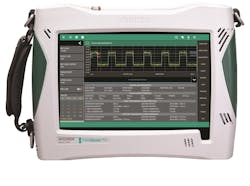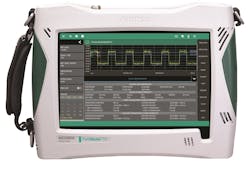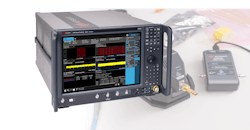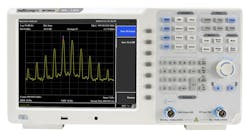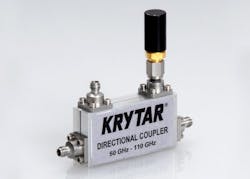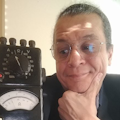2021 Special Report: Signal & Spectrum Analyzers
Download this article in .PDF format.
The crowded RF spectrum, compounded by the explosion in application spaces joining the cloud, demands advanced development tools able to provide deeper insights into signals and their measurement.
Our society is in the process of migrating toward a more expansive and extensive Cloud-based, IoT-oriented, and “smart” community where people, things, and the very neighborhood they exist in, are all connected and communicating. The shiny future consumers are growing to expect, however, involves a monumental amount of device and infrastructure development.
The tools needed to create this future are luckily powerful and extremely functional and can make the difference between a relatively easy development process and design hell. For this Special Report we asked some companies about their latest solutions to aid your design, test, and evaluation needs. Signal & Spectrum Analyzers are critical to measuring the performance in wireless application spaces as well as perform standards-compliant wireless measurements.
Interference mitigation
When we reached out to Anritsu about challenges in the RF development space, their first response was that the No. 1 challenge that network managers face is interference mitigation. This can be an extreme challenge, as interference comes from more and more sources and as the spectrum continues to crowd, especially with new 5G bands.
They presented the Anritsu Field Master Pro MS2090A real-time spectrum analyzer (https://www.anritsu.com/en-us/test-measurement/products/ms2090a) as having a level of performance never previously available in a compact, handheld instrument (Figure 1). These features include a frequency coverage up to 54 GHz to cover most popular signal standards, as well as a 110 MHz instantaneous capture bandwidth to support 5G carriers.
The Field Master Pro is also equipped with a wide variety of features to directly address interference. These include extremely fast real-time spectrum analysis (RTSA), IQ capture/streaming, coverage mapping, direction-finding tools, AM/FM audio output, and interference-hunting PC tools.
When it came to the question of the trends they are seeing in the area of Signal & Spectrum Analyzers, Anritsu said that on the premium end, analyzers continue to expand in frequency coverage and analysis bandwidth to match growing wireless signals. Viewing the spectrum isn’t enough, though. Instruments need to provide solutions to help track and analyze wireless signals. Real-time spectrum analysis is becoming increasingly valuable in the field for finding “signal-in-signal” or intermittent interfering sources.
Among the application areas Anritsu’s Signal & Spectrum Analyzers target, the two largest spaces include wireless and cellular customers (operators, regulators, network equipment manufacturers) and general-purpose test in aerospace and defense, satcom, intelligence, and commercial products. Their instruments are used for interference tracking/hunting, spectrum clearing, signal fidelity (i.e. radar measurements), and installation verification.
Capturing elusive signals
When we spoke about development challenges with Paris Akhshi, Product Marketing Manager at Keysight Technologies, she brought up the emergence of numerous high-frequency mmWave use cases, which are increasing bandwidth demands with higher-order modulation schemes, which allow for faster data rates. However, signals at mmWave frequencies are more susceptible to impairments, resulting in significant path loss between test and measurement instruments and the device under test (DUT).
The lower signal-to-noise ratio (SNR) makes signal analysis measurements, such as error vector magnitude (EVM), adjacent channel power, and spurious emissions, very challenging. This limits engineers from truly understanding the performance of their DUT. She explained that engineers need a test solution with the widest analysis bandwidth and highest frequency range available, to help them solve their most difficult test challenges in mmWave applications.
The system must isolate the DUT’s measured results from all other measurement setup effects that come from components between a signal analyzer and a DUT, or the test equipment itself. In the past, an external mixer was required to extend the frequency range of a signal analyzer, which due to the lack of a preselector at the front end of the mixer, led to unwanted images in the band of interest and degraded measurement accuracy.
Also, when measuring frequency outside of the mixer’s frequency band, engineers needed to reconnect the test signal to the signal analyzer’s RF input port or another mixer with a different band. Engineers also needed to change the input source from the corresponding operation interface. These extra steps increased test complexity and measurement uncertainty.
Keysight addresses these issues by integrating a preselector and an RF switch into a high-dynamic-range frequency extender, with a seamless operational interface to the signal analyzer. This enables a wide, unbanded, and preselected swept-power spectrum without managing band breaks and images.
The company’s N9042B UXA X-Series, is their latest flagship and is presented as the most powerful signal analyzer available. The N9042B along with a frequency extender deliver a single connection preselected to 110 GHz, with up to 11 GHz of analysis bandwidth, claiming the industry’s widest dynamic range and best residual EVM (Figure 2).
The company’s recently released millimeter-wave (mmWave) test solution, including the N9042B UXA signal analyzer and M9384B VXG signal generator, supports 4 GHz of corrected RF bandwidth for signal generation and analysis, as well as high-frequency coverage and the speed needed for wideband, high-throughput mmWave communications. Keysight’s PathWave X-Series measurement applications address ever-changing measurement requirements for the latest standards with ready-to-use measurements for a variety of mmWave applications.
89600 PathWave VSA software is a comprehensive set of tools for demodulation and vector signal analysis, with support for more than 75 signal standards and modulation types. PathWave VSA software enables engineers to explore virtually every facet of a signal and optimize their most advanced designs, while spending less time on measurement setup and delivering repeatable results.
Addressing mmWave
The use of mmWave frequencies is essential to accommodate more users in an RF spectrum that needs to be free of interference. Proposed LEO-satellite concepts, which orbit 500 to 2,000 kilometers from Earth, offer faster communications, and provide higher bandwidth per user than GEO satellites. In the radar industry, with the increase in vehicle-to-vehicle and vehicle-to-everything wireless communication, automotive radar requires the utmost reliability and performance. Therefore, isolating signals and ensuring EMI/EMC compliance are more important than ever.
Although mmWave technology is the key enabler for all these applications to provide ample margin for performance improvement, it creates challenges such as path loss, tight design margins, complex modulation, and stringent standards. Higher frequency ranges and wider bandwidths enable high-throughput data, range resolution and accuracy, and low latency, but also introduce more noise. The excessive path loss and noise increase test complexity and measurement uncertainties.
Therefore, engineers now, more than ever, need to take extra care to evaluate mmWave components and devices accurately using more advanced signal analyzers, that can deliver the high level of measurement accuracy, in the most reliable fashion. Two main mmWave target applications for N9042B UXA X-Series signal analyzer, are 5G and satellite communications.
In satellite communications, RF engineers need to ensure outstanding system performance through all stages of the satellite life cycle. Once a satellite is deployed, it cannot be called back for a repair. Similarly, testing 5G components and devices per the 3GPP 5G NR standard Release 15 and 16 requires a test solution with higher accuracy, sensitivity, and analysis bandwidth capability.
In mmWave communications, higher frequencies mean greater path loss and a lower SNR ratio, which make it very difficult to make precise measurements. Therefore, components and devices require better EVM performance as the modulation density increases to maintain the communication link. Engineers need to take extra care to design and validate the components and devices accurately, because of the inherent mmWave wideband noise that reduces the SNR and leads to poor measurements.
Keysight’s N9042B signal analyzer delivers considerable noise performance by leveraging a highly customized signal-path front end providing what is presented as the best swept-displayed average noise level (DANL) in the industry, down to -174 dBm at 1 GHz, and superior dynamic range for precise measurements of small signals near noise in the presence of large signals. Keysight’s latest mmWave test solution supports 4 GHz of corrected RF bandwidth for signal generation and analysis, as well as high-frequency coverage and the speed needed for wideband, high-throughput mmWave communications.
Standards compliance
Dr. Houman Zarrinkoub, Principal Product Manager, Signal Processing & Communications at MathWorks, brought up how ensuring that wireless systems conform to standard specifications is of paramount importance. The effect of RF propagation environments and channels, resulting in signal distortions, must be analyzed and verified at all appropriate frequencies. Base stations and mobile phones must be built and tested at the same frequencies, and this in turn drives the need for up-to-date application tools for analysis and test.
Hardware-based spectral analysis has its own inefficiencies. Configuring RF test equipment like signal generators and analyzers as well as Software Defined Radios (SDRs) to validate 5G and other communications signals over the air (OTA) can take too much time and is often cumbersome to set up. Using a configurable and programmable software environment allows for more repeatable and efficient signal analysis.
To satisfy speed and throughput needs, innovative algorithms such as OFDM, massive MIMO, and beamforming are introduced. This in turn adds significant complexity to the design and verification burden of wireless systems. In turn, the numerous combinations of design options within these systems provide a wide range of spectral characteristics to be adequately analyzed and validated.
To perform better conformance testing at new millimeter-wave frequencies, MathWorks has introduced software-based scopes, such as a spectrum analyzer, into several of their add-on products like DSP System Toolbox and RF Blockset. The spectrum analyzer shows a detailed spectrum of a simulated signal at a wide range of frequencies including millimeter waves. This enables specific measurements associated with the development of individual system components.
Since these spectrum analyzers are software-based, we don’t need to wait for RF circuitry necessary to transmit and receive millimeter-waves to be ready before we can test them. Using software models of radio-frequency frontends, power amplifiers and digital pre-distortion (DPD) units, we can perform simulated measurements. Measurements provided by the spectrum analyzer include channel power, occupied bandwidth, frequency offset, harmonic distortion and SNR, to name a few. The scopes also enable the design of custom measurement tools that can be used on live or prerecorded signals.
App-enabled analysis
Waveform generation is an important requirement for testing any design, and MathWorks’ Wireless Waveform Generator app makes the testing process easier and more interactive. It supports a wide range of wireless standard waveforms such as 5G, Wi-Fi, and Bluetooth, and integrates spectral analysis within the waveform generation environment. This, for example, enhances 5G NR testing by characterizing in both time- and frequency-domains in the app.
The app also supports off-the-shelf testing signals specified by standard documents including test models (NR-TM) as well as fix reference channels (FRC). As of release 2021a, it also includes custom 5G waveform generation in the app, which enables engineers to specify any arbitrary set of parameters and generate all types of 5G signals.
Signal and spectrum analyzers are evolving to support emerging trends and application areas, including requirements such as expanded support for mmWave frequencies, expanded signal bandwidths for enhanced broadband mobile applications, and support for analysis of low-delay transitory signals encountered in IoT and smart-industry applications.
MathWorks’ products are used for waveform analysis, algorithm design, and system development across a diverse mix of application domains and signal types. Notable examples include wireless communications, radar and sonar, audio, and noise and vibration. In the wireless area, the products are used to design and test wireless signals for low-power IoT applications, delay-sensitive vehicle-to-vehicle communication, and high-throughput cellular base-station applications.
What are your thoughts on market and industry trends in Signal & Spectrum Analyzers?
As 5G and other high-speed wireless connectivity standards get introduced, there's been an increase in the number of companies providing wireless testing products and services in the market. These new companies, small or large, are vying for market share in this competitive testing market and are customizing their offerings to distinguish themselves from the competition. Many of them use software solutions provided by companies like MathWorks to ensure that their solutions are compliant with standards specifications. This use case of such tools as a reference for design verification is an area that the company provides added value to the signal and spectrum analyzer development market.
Dr. Houman Zarrinkoub concluded by commenting that technology waves in mmWave applications, including 5G, satellite communications, and aerospace defense, are occurring at a faster pace. Advancements in frequency and bandwidth, in mmWave spectrum, and the surging demands in corresponding applications, is pushing demands to generate more advanced and powerful spectrum and signal analyzers, that can overcome mmWave measurement and testing challenges, in base station test, amplifier test, satellite communications, and automotive applications, to name a few.
Cost-effective test
The explosion in Cloud-based solutions has placed a lot of pressure on small developers and individuals in the area of test. To address this, Newark offers the MP700023 US Spectrum Analyzer from the company’s own brand, Multicomp Pro (Figure 3). This benchtop spectrum analyzer operates between 9 kHz and 3.6 GHz, and features 160dBm displayed average noise levels, 1.5dB total amplitude accuracy, excellent phase noise performance of 80dBc at 30KHz and a large 10.4" TFT LCD display. As the engineer’s choice, Multicomp Pro offers a complete product range of high-quality components, tools and equipment.
Newark also offers a range of Vector Network Analyzers from Pico Technology. PicoVNAs are all-new, professional USB-controlled, laboratory grade vector network instruments of unprecedented performance, portability and value for money. The PicoVNA 106 and PicoVNA 108 have a frequency range of 300MHz to 6GHz and 8.5GHz. Their simple outline, small footprint and low cost make them suitable for engineers working with limited bench space or budget, yet these Pico instruments boast a Quad RX four-receiver architecture to minimize the uncorrectable errors, delays and unreliability of internal transfer switches.
For excellent value in a high-function handheld 6 GHz Spectrum Analyzer, the Aim-TTi PSA6005USC Handheld 6 GHz Spectrum Analyzer combines small size with light weight for true portability, making it useful for field-testing of RF Signals. It operates between 10 MHz and 6 GHz, with resolution bandwidths from 300Hz to 10MHz (1:3:10), and zero span mode with AM and FM audio demodulation.
Multidomain analysis
When we talked to Amr Haj-Omar, Market Segment Leader at Tektronix Wireless, he emphasized that their SignalVu-PC offers a single-user interface supporting all signal acquisition hardware (benchtop or portable) from DC to 70 GH. Spectrum analyzers and oscilloscopes with SignalVu-PC allow you to view “live” spectral content, perform analysis in the frequency, time, and modulation domain, all at the same time. Tektronix wideband AWGs allow you to generate and simulate any test signal in an unlimited number of wireless/RF environments.
Among the applications addressed by the company’s SignalVu and Spectrum View software are vector signal, spectrum, and modulation analysis using Tektronix Oscilloscopes and Spectrum (Signal) Analyzers. Spectrum View is available on the 4/5/6 Series MSO Oscilloscopes, transforming these instruments into multichannel signal analyzers with fully time-correlated and simultaneous analysis in both frequency or time domain on each channel.
For needs beyond basic spectrum analysis or RF vs. Time analysis, SignalVu/-PC offers the same UI across instruments, with EMI and Field Testing, in powerful, compact, and cost-effective packages. DPX spectrum and spectrogram displays reveal transient EMI, with an advanced EMI precompliance and troubleshooting application option (EMCVu) which automates the process of duplicating standards based measurements for Radiated/Conducted emissions.
Dylan Stinson, Tektronix Product Manager for RF Products, pointed out their RSA5100B offers up to 165 MHz real-time bandwidth from 10 Hz up to 26.5 GHz, and is presented as the only fully preselected real-time instrument in its class. The RSA7100B provides up to 800 MHz real-time bandwidth, with hours of I/Q recording capacity on a terabyte drive and a high-speed controller. The RSA306B, RSA500, and RSA600 Series Real Time Spectrum Analyzers offer up to 40 MHz real-time bandwidth from 9 kHz up to 18 GHz, with a USB interface and battery capability.
Tektronix also addresses validation of commercial wireless physical-layer modulation types and standards with SpectrumView on 4/5/6 Series MSO Oscilloscopes, using DDCs (Digital Downconverters) for separate signal path for time & frequency, and phase-matching between channels, which is critical for beamformer calibration. It’s a one-box solution that can also analyze digital and analog/RF simultaneously, to analyze latency requirements.
There is a need to analyze digital, analog, and RF to be able to address latency requirements, phase measurements for the beamformer, and MIMO. Hence, the 1-channel solution, with the spectrum analyzer, with its limited bandwidth, is creating an unmet need and trend toward scopes to address these concerns based on a 1-box solution, such as the 6 Series B MSO. DDCs (Digital Downconverters) on each channel allow for separate RF paths, allowing for independent time and frequency measurement.
Spectrum analyzer customers are putting more emphasis in the software and applications that support the instruments, with 5G applications driving new testing scenarios over-the-air (OTA) using multiple-channels or time-correlated RF. The Tektronix MSO Oscilloscopes with dedicated DDCs on each channel and SpectrumView and SignalVu-PC software, is a new/alternative way to test for RF that the traditional RF engineer would have previously not considered, and offers benefits for analyzing both time, frequency, and code domains simultaneously across multiple channels.
No connection, no solution
KRYTAR specializes in the manufacture of ultra-broadband mmWave, microwave, and RF components and test equipment. The company's product line includes directional couplers, directional detectors, 3 dB hybrids, MLDD power dividers/combiners, detectors, terminations, coaxial adaptors and a power meter, covering the DC to 110.0 GHz frequency range.
For example, the company’s latest directional coupler, Model 1500110010, offers some of the widest frequency coverage used on the market. This directional coupler maintains a flat 10 dB coupling across a wide 100-GHz bandwidth, and lends itself to wireless designs and many test and measurement applications for emerging mmWave and 5G markets. (Figure 5).
About the Author
Alix Paultre
Editor-at-Large, Electronic Design
An Army veteran, Alix Paultre was a signals intelligence soldier on the East/West German border in the early ‘80s, and eventually wound up helping launch and run a publication on consumer electronics for the US military stationed in Europe. Alix first began in this industry in 1998 at Electronic Products magazine, and since then has worked for a variety of publications in the embedded electronic engineering space. Alix currently lives in Wiesbaden, Germany.
Also check out his YouTube watch-collecting channel, Talking Timepieces.
